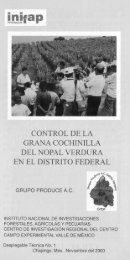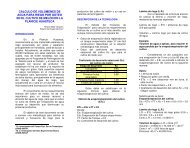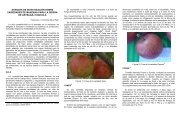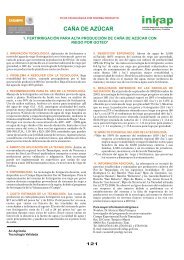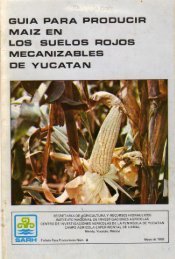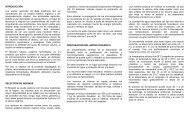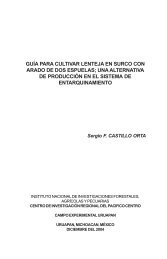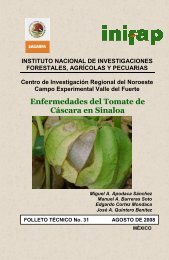Abrir - Bienvenidos a la Biblioteca del INIFAP - Instituto ...
Abrir - Bienvenidos a la Biblioteca del INIFAP - Instituto ...
Abrir - Bienvenidos a la Biblioteca del INIFAP - Instituto ...
You also want an ePaper? Increase the reach of your titles
YUMPU automatically turns print PDFs into web optimized ePapers that Google loves.
7.- Verter en <strong>la</strong> charo<strong>la</strong> de <strong>la</strong> cámara horizontal de electroforesis, con el peine<br />
puesto<br />
8.- Dejar enfriar totalmente hasta que este sólido<br />
9.- Colocar en <strong>la</strong> cámara (de negativo a positivo, los pozos van en el polo<br />
negativo).<br />
10.-Adicionar Buffer TAE a <strong>la</strong> cámara hasta <strong>la</strong> marca indicada<br />
11.- Poner <strong>la</strong>s muestras en cada pozo.<br />
12.- Poner <strong>la</strong> tapa, y correr a 100 volts, de 40-60 minutos<br />
Finalmente, el resultado se podrá observar en una cámara con luz ultravioleta,<br />
sólo se recomienda tener cuidado con el EtBr.<br />
La metodología descrita en este capítulo podría ser adaptada a <strong>la</strong>s condiciones<br />
de los helmintos que se desean diagnosticar. Asimismo, <strong>la</strong> biotecnología es<br />
actualmente una ciencia que va creciendo y se va perfeccionando, nuevos<br />
programas de software, así como nuevos genes se están notificando, muchos<br />
de ellos para <strong>la</strong> aplicación de diagnóstico. Otro ejemplo de diagnóstico<br />
molecu<strong>la</strong>r, podría ser <strong>la</strong> identificación de citocinas implicadas en <strong>la</strong> resistencia<br />
y susceptibilidad de ganado, cuya aplicación podría integrarse a <strong>la</strong> selección<br />
de individuos altamente susceptibles o a <strong>la</strong> ganadería con problemas severos<br />
de resistencia antihelmíntica. A este respecto, sugiero <strong>la</strong> integración de<br />
alternativas de diagnóstico, como son <strong>la</strong>s herramientas molecu<strong>la</strong>res junto con<br />
<strong>la</strong>s parasitológicas, c<strong>la</strong>ro, esto va a depender de <strong>la</strong>s posibilidades <strong>del</strong><br />
productor, y de los <strong>la</strong>boratorios de diagnóstico a nivel nacional.<br />
Literatura citada<br />
1. Allonby E, Urquhart GM, 1975. The epidemiology and pathogenic<br />
significance of haemonchosis in a Merino flock in East Africa. Veterinary<br />
Parasitology 1:129-143.<br />
2. Ashman K, Mather J, Wilshire C, Jacobs HI, Meeusen E, 1995. Iso<strong>la</strong>tion<br />
of <strong>la</strong>rval surface glycoprotein from Haemonchus contortus<br />
and its possible<br />
role in evading host immunity. Molecu<strong>la</strong>r and Biochemical Parasitology<br />
70:175-179.<br />
3. Bautista-Garfias R, López-Arel<strong>la</strong>no ME, Sanchez-Albarrán A, 1989. A<br />
new method for serodiagnosis of sheep Fascio<strong>la</strong>sis using helminth<br />
excretory-secretory products. Parasitology Research 76:135-137.<br />
4. Cox GN, Shamansky LM, Boisvenue RJ, 1989. Identifaction and<br />
preliminary characterization of cuticu<strong>la</strong>r surface proteins of Haemonchus<br />
contortus.<br />
Molecu<strong>la</strong>r and Biochemical Parasitology 36:233-242.<br />
5. Curtis RH, 1996. Identification in situ and in vitro characterization of<br />
secreted proteins produced by p<strong>la</strong>nt-parasitic nematodes. Parasitology<br />
113: 589-593.<br />
6. Dalton JP, Brindley PJ, Knox DP, Brady CP, Hotez PJ, Donnely S, O`Neil<br />
O, Mulcahy G, Loukas A, 2003. Helminth vaccines: from mining genomic<br />
information for vaccine targets to systems used for protein expression.<br />
International Journal for Parasitology 33:621-640.<br />
165



